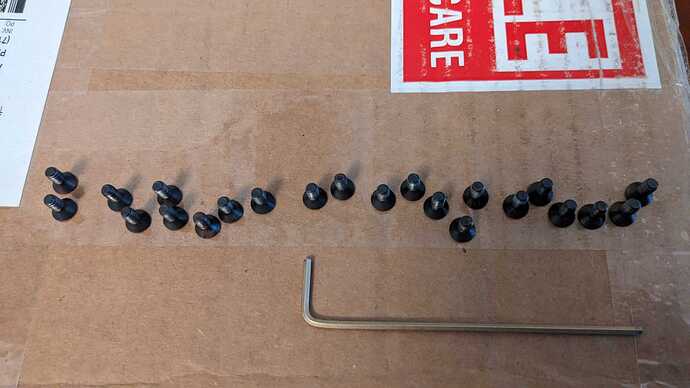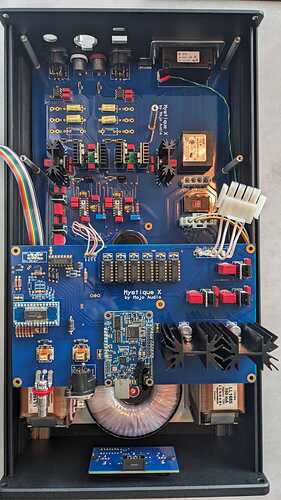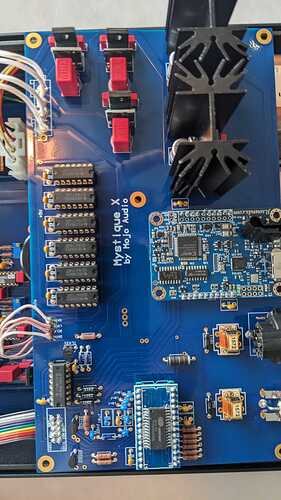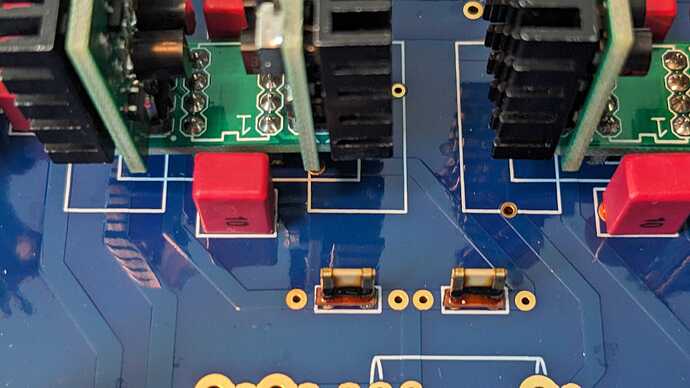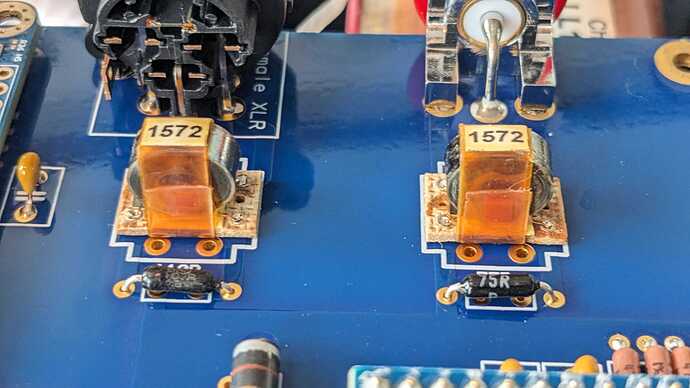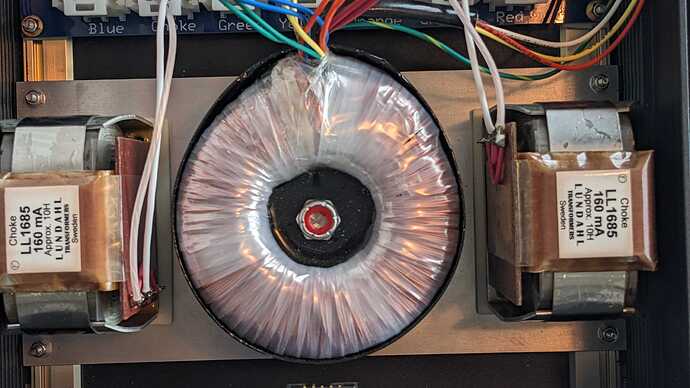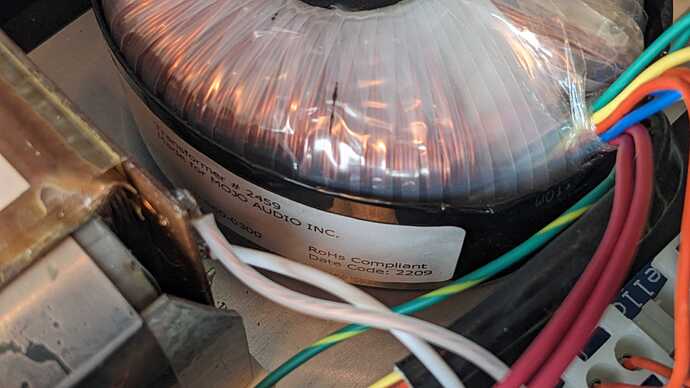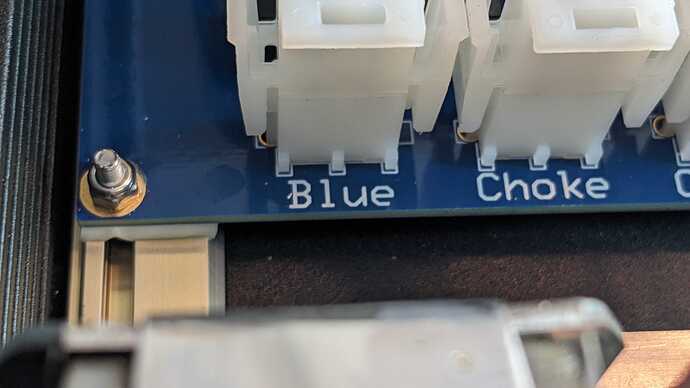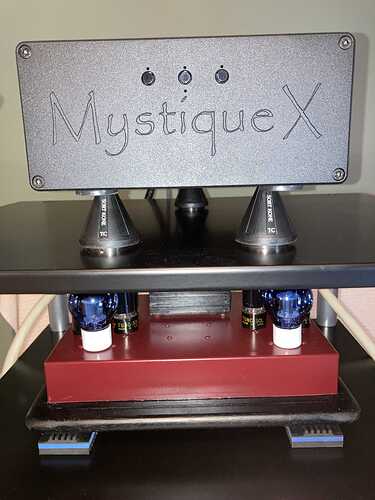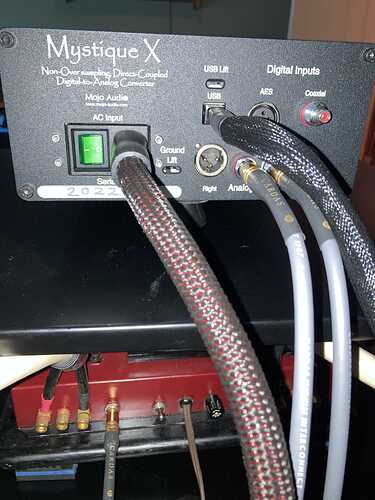Probably $1K in chokes alone in that PSU, interesting choice for a SS device
It’s always interesting to see designers priorities when it comes to audio circuits.
As far as I can tell on the left you have the DAC chips and the output section, which is composed of
basically 2 discrete op-amp stages, and a 3rd opamp chip for SE to balanced output or the other way around.
Not sure what the caps are for in the middle, they are too small to be coupling caps, maybe some sort of high frequency feedback.
But you also have seperate what I assume are voltage regulators for every stage, 4 for the DAC, 2 each for the subsequent opamp stages (I assume one for +Ve and one for -Ve), and a lot of decoupling capacitors.
Clearly a designer who thinks power quality is everything, and I guess hence the big expenditure on chokes in the PSU.
That is his stated method of operation. He’s also got the power supply components sitting on sorbathane sheets for damping. One interesting thing is that I couldn’t see clocks on the board. They may be underneath the USB board (JL Labs) but every implementation of DACs I’ve ever seen there is an attempt to keep the clocks as close to the DAC chip as possible. So perhaps they’re on the bottom of the board?
This is how many screws I had to take off to take the top off cover. The bottom has twice as many and some are larger as they hold down the transformers, so not going there.
I believe the only clock required by the AD1862 is the serial clock, and that’s coming into the board on the bottom right, so likely on the center board, I can’t read the text on the chips in the middle at the bottom.
Maybe under what I assume is a uController in the middle of the board.
Getting a little sidetracked here but from my understanding the USB inputs need a PLL clock for synchronization and don’t have anything to do with clocking outside of that. I know that AES and SPDIF get their clocking externally so again no clock needed there. So the DAC whatever is it needs a clock signal to output the right amplitude at the right time. I’ve actually read that time accuracy isn’t important in audio, jitter is. So how consistent the clock is not how well it keeps time.
I should still see a clock and I don’t and my OCD needs sating. Maybe a question to Ben is in order. lol
There are 2 clocks for the USB conversion on the JLSounds board, just looking at the board I’d guess he’s taking SPDIF out of that, rather than I2S, and doing the final conversion to the serial format for the AD1862 in what I assume is the uController, on the daughter board in the middle. It needs clocks for that and that would subdivide down to be the final audio clock, which is why I guessed the Xtal was under that board.
If the thing in the middle isn’t a uController, there could be custom firmware on the JLSounds board, but it doesn’t look like it’s taking the SPDIF in and the standard one doesn’t take SPDIF.
But it’s all guess work.
Yes this is true within reason, you wouldn’t notice something playing 1% slower or faster than intended, because all the relative pitches would still be consistent, you do notice Jitter. One of the reasons that quoting the accuracy of an external clock or it’s drift over time is largely meaningless.
I heard back from Ben, this is what he said in his email. Sounds like the same thing you’re describing but it’s out of my depth other than at at high level. It perhaps also explains why you’ve noted that Lampizator would go through the trouble of upgrading the clocks on the USB input board.
The USB is asynchronous and reclocks 44/48 with the clocks on the USB module.
The S/PDIF is clocks to the external clock in embedded into the S/PDIF source: the better your S/PDIF source the better your S/PDIF clocking.
One of the big things that can make S/PDIF better than other sources is that the clocking is outside of the DAC chassis (like a master clock) so the clocking noise is kept outside of the chassis.
That is why quite a few DAC manufacturers, such as Berkeley and Bel Canto, have external USB components with AES or S/PDIF intputs into their DACs.
On our new Mystique X series there is even a USB lift switch to remove 100% of the internal clocking (and clocking noise) from inside the DAC’s chassis.
This is also why when our DACs are played using an incredible digital source such as the Jay’s Audio CDT-3 MkIII CD transport the sound rivals the best of analog.
When S/PDIF or AES are reclocked inside the DAC as some companies do not only are you bringing clocking noise inside the DAC’s chassis, you are limiting the clocking to the DAC’s internal reclocking circuit as opposed to allowing the DAC to rise to the level of whatever external clock is being used.
My contribution to @Souldriver Mystique X+ tour. I’ve started calling it an X+ because it’s got a number of the upgrades the X SE has. The two most important actually, the Lundahl amorphous choke and SPDIF amorphous transformers.
This is what the “naked” Vishay TX2575 resistors that Ben puts in his SE or Pro versions look like.
The cutest littlest transformers you’re ever going to see. Placed in the SPDIF input path.
The last pics show the vibration damping Ben uses under components and PCB.
Are the da chips on the input board? If so, does ir have the same number of chips as the pro? I was under the impression the pro had 6 and the x had 2 tbh
Chips or chokes? There are more chokes on the evo.
Actual DA chips
No all there is, is a serial converter, which is taking the SPDIF signal from the input and converting it for the DA chip, a buffer, and a bunch of counters that are likely deriving a lower clock from a higher one.
I’d assumed the surface mount chip with the socket was a uController, but it’s. Hardware SPDIF to serial converter.
DA conversion and output buffer are on the bottom board it’s very similar to the other one.
And I think the capacitors on the output are a part of an analog low pass filter. If both caps are in parallel, the filters at 14KHz which is very aggressive, but it’s probably a 2nd order filter and cutoff is closer to 21KHz
I have a borrowed Mojo Mystique X DAC in house that i get to play with for a short while. I powered it up promptly in order to get it to warm up appropriately the next few days. I wanted to jot down some listening experiences and if anything changes over the next week i will continue writing about it.
This is a 2022 model w/ a few of the internal upgrades, just not sure which.
Today’s listening chain: ROON > Uptone Audio EtherREGEN > Innuos Zenith mkIII streamer > Mojo Mystique X being fed USB > RCA out to LTA MZ3 (pre-amp mode) > Lance Cochrain push pull style 6L6 based amplifier > Spatial Audio M4 Triode Master spkrs. / single REL T7/i (sub)
The first few hours were fun as my mind struggled and i stumbled internally to put into words the differences between what i was hearing with this DAC vs the Lampizator Baltic3 model i just pulled out of this chain. Later in the evening, about 10 hrs into the listening session i had my little “Ah-ha” moment and it all came together. The Mystique X provides a sonic listening profile very similar to my Sonnet Pasithea DAC! ![]()
First things first, i very much like the Mojo Mystique X, this is a no brainer for me and I would add one of the Mojo models to my collection without blinking twice.
-
Separation between instruments was absolutely stunning and there is no “sharp overly defined edge”, it is a beautiful example of quality resolution while also maintaining a soft and musically pleasing quality to the separation.
-
Depth of the soundstage, this was the sonic quality which was stumping me in its presentation until i realized it was exactly what threw me off about the Sonnet Pasithea too. The Mystique does soundstage depth really well and this is a quality of R2R based DAC’s i am starting to recognize, the very first time i took note of this quality was while i was enjoying @Veritas Lampizator Golden Gate DAC at his home and enjoying the beautiful image his system at the time was presenting to my ear and mind. The quality, best i can describe it, is as if i am sitting in a small venue and the musicians are playing on a smaller stage, it is oblong and i am part of the audience sitting at a seat right in front of the stage, which if i stretched and reach out, i can touch a musicians arm while very obviously knowing there are a group of musicians on the stage behind and to the sides of this one. It’s a beautiful quality and brings the separation of some of the instruments forward of the speakers.
 i think this may be the most obvious sonic quality of the model that most folks find engaging or interesting. Other high quality DAC’s usually keep the depth behind the speaker plane of the soundstage, ie. my B3, LM-32 and Berkeley. My Exogal brings it a bit more forward but not as much as the Pasithea or Mojo.
i think this may be the most obvious sonic quality of the model that most folks find engaging or interesting. Other high quality DAC’s usually keep the depth behind the speaker plane of the soundstage, ie. my B3, LM-32 and Berkeley. My Exogal brings it a bit more forward but not as much as the Pasithea or Mojo. -
Lastly there is a certain quality of the tone that is so beautiful that this DAC helps bring out. It’s soft but not, the level of resolution and detail are there but i think the bottom end tone has a certain richness that translates into the rest of the sonic signature. At first i thought i needed to adjust my subwoofer to the DAC and it was simply bringing forth too much bloom but as I sampled various genres i found that i liked it more and more. I will next turn the sub off and listen to the speakers only and also try this DAC with HP’s to see how the bottom end tone comes across, i just don’t see any negatives to this, it was enjoyable but i need a larger and more varied sampling for my own satisfaction.
-
The overall soundstage width seems appropriate to the style of the bubble of space the DAC presented on my chain on this one particular room set-up. The amp i was using also runs more upper frequency resolute and leaner than my usual mono-block set-up so i am curious to try the DAC w/ various amplifiers to see what other variances i can identify.
I am using USB input, this is considered the weakest input of this DAC by some folks whose opinion i value. I will try the AES and possibly the SPIDIF inputs but on this particular chain i have what i consider the most solid USB output, i have had in any variation over the years in any of my set-ups. The etheregen is doing a very solid job, i detect NO issues w/ the USB and i am using an FTA Calisto USB which i find usually provides a richer overall sonic character than my other USB cables. I have cables that lean a bit more neutral or have a more resolute and detail oriented feel, I hope to get to them too if time allows. ![]()
So very happy to have this opportunity to play with this DAC, it’s got a wonderfully fun presentation and i have a feeling i will absolutley love using it w/ Headphones! ![]()
More to come…
Good job summarizing the initial impressions… ten hours long initial impressions. lol
I think you kind of said what I couldn’t put into words myself, it’s just not got any “negatives” to it. It does everything well.
Officially listed upgrades, this is an X with the S/PDIF upgrade which includes an amorphous core input transformer, SiC Schottky diode upgrades.
Unofficially when we looked inside it looks like it also had anti-vibration mounting pads from the SE as well.
@dB_Cooper , help me label the sonic character of this DAC, I’ve been listening to it all morning using HP’s on an LTA MZ3 and HP use versus speaker presentation is always differing to my ears.
For example, the Lampi B3 in general across most forums is known as being neutral with a warm tilt in stock form w/ a slight ability to tilt character a bit w/ tube rolls. It is also fairly well known for its ability to throw what many would consider a large soundstage. I find it ok with HP use but in general hands down prefer it’s qualities on 2 channel because in the HP space the qualities don’t come out as well.
The Mojo Mystique is NOT neutral, the tonal character it exhibits under the current conditions I have it playing would to me, fall under “warm” but absolutely NOT relaxed, very much like I described the Sonett Pasithea it shows emphasis across the spectrum low, mid and high, all of which it does with a certain smooth character that’s very well executed. Problem is I would label it more on the “fun” side with this emphasis in the 2 channel world and the forward stage depth it has the ability to throw.
I am not catching the same stage depth with HP use, but the separation in the instruments is excellent which creates a great soundstage image in my head. I don’t find it pushing mids or anything particularly forward, and the resolution is top notch which does good things for many other qualities, it’s this weight that seems to be added that makes me want to call it warm ![]() when used with headphones. Watcha’ think?
when used with headphones. Watcha’ think?
I don’t know if warm is the right word, it’s more like body or weight or volume. They are on the warm side for sure but the X is a very technical DAC by anyone’s standards if you’re simply evaluating things like instrument separation, placement and the space it’s able to create. It does this technical thing while remaining organic and fun though. I remember my Weiss 502 which was VERY organic but could be perceived as too dry or not a fun presentation by comparison.
That said, I had the opposite experience to what you’re describing as I liked it better in a HP environemnt rather than two channel because the shortcoming of it on the EVO pro in being able to create a more enveloping sonic presentation.
To use your analogy where you’re sitting on the front row. (something @Snooze said when she came over to visit) you’re sitting in the space where the musicians are playing and you can often hear sounds in 200° field with the right recordings. That said the X offers a bit more detail. In huge part because I think it’s a got a quieter background so you’re able to pick out more.
Headphones to me just squash everything and it’s all either in your head or it’s 2 inches away from your head so hard to really get a much of a sense of something that creates space so convincingly like the EVO Pro has bee showing me.
The Mojos in think are inherently more forward and maybe that’s why you’re getting more of that front row experience?
You’re really making me want to listen to the Pasithea now.
It’s absolutely body, and weight, I am enjoying what it does, my question is if it’s not neutral, not warm and has this fun character, what do we call it ![]() I’m stuck…
I’m stuck…
Just another flavor of beef stew? The Vietnamese with style with sriracha and star anise, the Cuban one my mom would make heavy on the tomato paste with cumin or the French way with butter and red wine. They’re all very good in their own way.
It’s got “cojones”.
